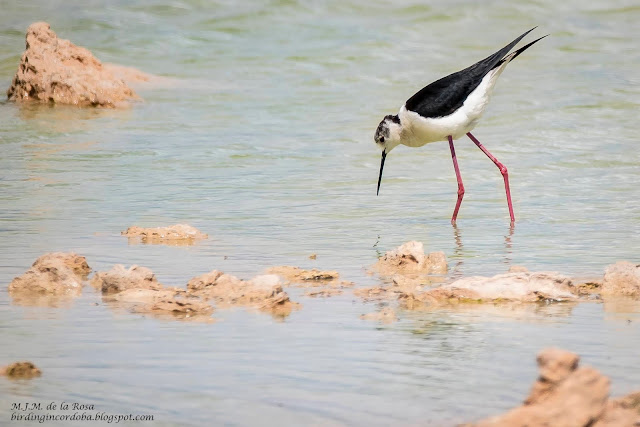The extreme
heat in Cordoba in August can make birdwatching quite a challenge. So to escape we
decided to take a trip to the coast and meet up with members of the Andalucia Bird Society for their monthly field trip. The Guadalhorce River, the main river of
Malaga Province, reaches the sea just west of the city. The site contains a
number of ponds surrounded by tamarisks and reeds and the larger
pools have open mud suitable for waders.
We set out
just before 10 o’clock and it was already getting uncomfortably hot. Leaving Guadalmar
we crossed the pedestrian bridge and spotted a male Little Bittern landing in
the reeds. Arriving at the first pond we saw many Black-winged Stilts, Little-Ringed
Plovers, Little Egrets and Coots. We also observed Little Grebes and
Black-necked Grebes as they dived to catch their prey.
A little
further along the path was the next pond with a hide. Here the first thing I saw
was a Pacific Golden Plover in full summer plumage. I had read that it had been seen here in the previous few days, but I was not expecting to find it so easily. It breeds in Northern Siberia and Western Alaska and is a very
rare vagrant to Spain. In appearance it is very similar to the Golden Plover, but it has longer legs and its body is slightly slimmer, although without a European Golden Plover to compare it to these differences were hard to see. We were able to
observe it for some time as it fed in the shallow water alongside a Greenshank
and a Redshank. There were also Black-winged Stilts and Little-Ringed Plovers
as well as a few Common Sandpipers.
 |
| Pacific Golden Plover |
In the trees
behind us we could hear a Cetti’s Warbler calling and through the scope we had a Spotted
Flycatcher sitting next to a Chameleon. A couple of White Storks flew past and as we walked to the next hide we disturbed a Common Kestrel, which promptly flew off into the distance.
 |
| Spotted Flycatcher |
The pool at the next stop had quite a few Little Grebes, Coots and Moorhens, as well as Pochard and a White-Headed Duck. More ulian Dunkerton have appeared from the reeds if we had waited, but it was really starting to get hot so we continued on the path to the last hide. On the way we saw some Grey Herons flying over the reeds and Zitting Cisticolas zipping into the bushes.
 |
| Grey Heron |
The next hide overlooked a large pool with some small islands in it. It was full of Lesser Black-Backed Gulls and in amongst them were some Black-Headed Gulls and at least four or five Audouin's Gulls. Gulls do not normally get me very excited but these were an interesting find. Named after a French naturalist, Jean Victoire Audouin, they are only found off the west coast of Africa and around the Mediterranean. In the 1975 they were one of the world's rarest gulls with a global population of about 2000 birds. Currently populations are around 19,000 pairs with 90% of them to be found in Spain. This increase has been put down to the birds feeding on waste from the fishing industry, although changes in practices could lead to problems in the future.
We could also observe Little-Ringed Plovers running along the muddy banks between the Common Sandpipers and Black-Winged Stilts and in the deeper water a pair of Flamingos were feeding. And with the temperatures continuing to rise it was time to walk back to the car and head to a 'Chiringuito' to rehydrate and enjoy a swim in the sea.





Been there three times going to and from the airport. Always good birds, I remember getting osprey and kingfisher, and being very warm.
ReplyDelete